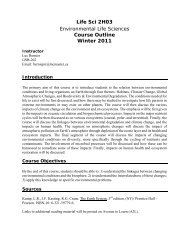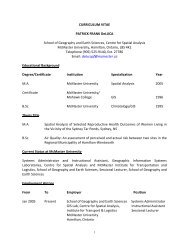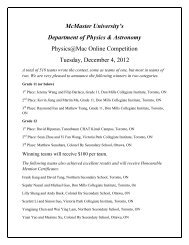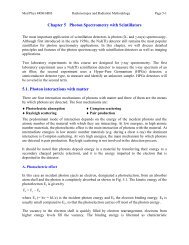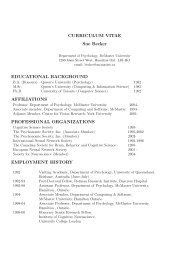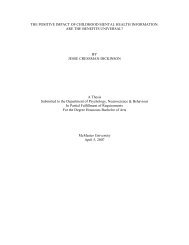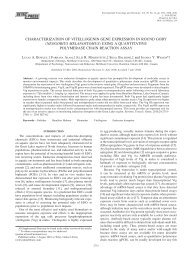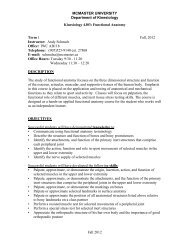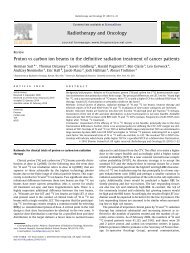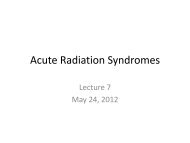Chapter 9 - Radioprotectors
Chapter 9 - Radioprotectors
Chapter 9 - Radioprotectors
You also want an ePaper? Increase the reach of your titles
YUMPU automatically turns print PDFs into web optimized ePapers that Google loves.
<strong>Radioprotectors</strong><br />
Prepared by Du Le<br />
MED PHYS 773 (2013)
Objectives<br />
To introduce types of radioprotectors<br />
(against indirect mode of ionizing<br />
radiation) that are commonly used in<br />
clinics as well as in radiation research.<br />
To discuss pros and cons of each<br />
radioprotector and its future direction (if<br />
applicable)
Definitions<br />
– <strong>Radioprotectors</strong><br />
– Dose reduction factor<br />
Outline<br />
Discovery and mechanism<br />
– Cysteine (SH-compounds)<br />
– Loman et al’s experiment on Thymine<br />
– Development of more effective compounds<br />
– Requirements of a radioprotector<br />
Classification of <strong>Radioprotectors</strong><br />
– Prophylaxis (Pre-exposure protection )<br />
Systemic Hypoxia<br />
– Mitigation (shortly after exposure)<br />
Radical Scavengers<br />
– Amifostine<br />
– Nitroxides<br />
– Superoxide dismutase<br />
– Selenium<br />
– Treatment<br />
Stem cell therapy<br />
Intervention in the angiotensin pathway<br />
Anti-inflammatory treatments<br />
Growth factor treatments<br />
Summary
<strong>Radioprotectors</strong>: Definition<br />
<strong>Radioprotectors</strong> are agents or compounds<br />
delivered prior or shortly after radiation<br />
exposure with the intent of preventing or<br />
reducing damage to normal tissues.<br />
- Citrin et al., The oncologist (2010)
Dose reduction factor (DRF)<br />
DRF is used to describe the effectiveness of a<br />
radioprotector.<br />
– Higher DRF, better protection to normal cells against ionizing radiation<br />
DRF is expressed as the ratio of dose of radiation in the<br />
presence of the drug to dose of radiation in the absence of<br />
drug to produce a given level of lethality<br />
Example: Considering the same mice population<br />
– 100 Gy is 50% lethal dose in mice in presence of cysteine<br />
– 80 Gy is 50% lethal dose in mice in absence of cysteine<br />
– What is DRF?<br />
100Gy<br />
DRF<br />
<br />
80Gy<br />
<br />
1.<br />
25
Discoveries of <strong>Radioprotectors</strong><br />
In 1948:<br />
– Patt discovered that cysteine (a sulfhydryl<br />
compound) could protect mice from effect of total<br />
body exposure to x-rays if the drugs were<br />
injected in large amount before radiation<br />
Effect of cysteine on Thymine concentration was also<br />
demonstration later<br />
– Loman et al’s experiment (1970)<br />
– Bacq discovered cysteamine could also protect<br />
animals from total body irradiation<br />
Cysteine<br />
Cysteamine
Discoveries<br />
(Cont.)<br />
Patt’s results:<br />
– Pre-treatment with<br />
cysteine reduced<br />
toxicity in total body<br />
X irradiation.<br />
– Increasing Cysteine<br />
dose fo could<br />
increase survival<br />
rate.<br />
– All injections were 5<br />
mins before<br />
irradiation.<br />
H.M. Patt et al. Science (1949)
Patt’s results:<br />
– Injection of cysteine immediately after exposure was ineffectual<br />
– Similar high survival rate was obtained when cysteine was given 5<br />
mins or 1 hr before exposure<br />
– H.M. Patt et al. Science (1949)
Indirect action of Cysteine on Thymine<br />
Loman et al.’s experiment (1970)<br />
– Expose Thymine (5 X10 -4 M) in the excess of alcohol<br />
radicals with dose rate of 46.5 Gy/ minute.<br />
– Thymine concentrations were determined with a<br />
spectrophotomer.<br />
– The destruction of thymine was measured by following<br />
the decrease in optical density as a function of radiation<br />
dose rate per volume.<br />
Optical density is proportional to concentration<br />
– Small cystein concentration (10 -4 M) was added before<br />
exposing for comparison with the control sample
Indirect action of Cysteine on Thymine (cont.)<br />
Loman et al.’s results (1970)<br />
No cystein added experiment<br />
– Thymine concetration was strongly reduced<br />
– Radicals produced from alcohol due to ionizing radiation were able<br />
to destroy the thymine chromophore, with a rate constant of the<br />
order of 105 M -1 sec -1<br />
Cysteine added experiment<br />
– Small or no change in Thynine concentration<br />
– H-atom was transfered from the sulfhydryl compound to the<br />
alcohol radicals, thus preventing the reaction of the organic radical<br />
with thymine<br />
– This type of indirect protection of a DNA constituent could be<br />
importance for the radioprotection of DNA in living cell
Indirect action of Cysteine on Thymine (cont.)<br />
If cysteine concentrations were increased, the bending<br />
down of the dose-effect curve would be delayed<br />
10 -4 M cystein<br />
2*10 -4 M cystein<br />
3*10 -4 M cystein<br />
Irradiation of solutions of 5 X 10 -4 M Thymine + N20 +<br />
0.5 M ethanol and (1) 10 -4 M cystein ; (2) 2x 10 -4 M<br />
cystein; (3) 3x 10 -4 M cystein<br />
- Loma et al. Radiation Reasearch (1970)
Development of more effective compounds<br />
Cysteine is toxic and induces nausea and vomiting.<br />
In 1959, U.S. Army initiated a program at Walter Reed Institute to<br />
indentify and synthesize drugs capible of protecting individuals from<br />
radiation enviroment without deliberating toxicity of cysteine.<br />
– More than 4,000 compounds were synthesized and tested.<br />
Toxicity of cysteine could be greatly reduced if the SH group was<br />
covered by a phosphate group. Once in the cell, the phosphate group<br />
will be stipped and SH group will scavenge for radicals<br />
– 50% lethal dose of the compound can be doubled<br />
– DRF can be greatly enhanced<br />
Radiobiology for the Radiologist
Development of more effective<br />
compounds (cont.)<br />
Two typical compounds of more than 4,000 synthesized:<br />
– Cystaphos (WR-638): used during Cold War<br />
– Amifostine (WR-2721):<br />
Most effective radioprotector of those synthesized<br />
Good protetcion to blood organ, DRF for 30-day dealth in mice nearly<br />
maximum value of 3<br />
Carried and used by US astronauts if a solar event occur<br />
Radiobiology for the Radiologist
Requirements for <strong>Radioprotectors</strong><br />
Should be selective in protecting normal tissues<br />
from radiotherapy without protecting tumor<br />
tissue.<br />
Should be delivered with minimal toxicity.<br />
Should protect normal tissues that are<br />
considered sensitive such that acute or late<br />
toxicities in these tissues are either dose-limiting<br />
or responsible for a significant reduction in<br />
quality of life<br />
- Citrin et al., The oncologist (2010)
Recall: Events following radiation exposure<br />
- Citrin et al. The Oncologist (2010)
Classification of Radioprotector (indirect<br />
mode protection)<br />
Prophylaxis<br />
(Pre-exposure protection)<br />
Mitigation<br />
(during or shortly after<br />
exposure)<br />
Treatment<br />
Systematic Hypoxia<br />
Amifostine<br />
Nitroxides<br />
Superoxide dismutase<br />
Selenium<br />
Stem cell therapy<br />
Intervention in the<br />
angiotensin pathway<br />
Anti-inflammatory treatments<br />
Growth factor treatments
Prophylaxis
Recall: Oxygen Effect on Survival Curve<br />
Cells are much more sensitive to x-rays in the presence of<br />
molecular oxygen than in its absence (i.e., under hypoxia).<br />
Introduction hypoxia could be expected to reduce radiosensitivity in normal<br />
tissues<br />
Radiobiology for the radiologists, Chap. 6
Systemic Hypoxia (cont.)<br />
Systemic reduction of oxygen partial pressure can be achieved by<br />
breathing air with a reduced oxygen concentration<br />
The protection factor : dose required for a specific effect with<br />
reduced oxygen compared with the dose giving the same effect<br />
with normal oxygen breathing<br />
In single-dose: protection factors in the range of 1.2 –1.4 have<br />
been observed.<br />
In radiotherapy: systemic hypoxia is associated with an increase<br />
in the fraction of hypoxic cells within the tumour<br />
– → an increase in tumour radioresistance<br />
– → Precluded for the amelioration of radiotherapy complications
Example: effect of BW12C on tumour<br />
hypoxia<br />
An increase in the binding of oxygen to haemoglobin by BW12C (5-[2formyl-3-hydroxyphenoxy]<br />
pentanoic acid) - an agent for the treatment<br />
of sickle cell anaemia → reducing availability of oxygen in normal<br />
tissues, with protection factors between 1.0 and 1.3.<br />
Normal blood cells<br />
Sickle cells<br />
http://www.nhlbi.nih.gov
Honess’ experiments<br />
Example (cont.)<br />
Either RIF-1 or KHT tumor was injected to mice legs<br />
Tumour-carrying-mice were injected with BW12C (70mg/kg) 30 mins before<br />
being exposed to dose rate at 67.4 cGy/min.<br />
Results:<br />
– BW12C has no effect on survival of unradiated cells.<br />
– BW12C-injected tumours are more sensitive to radiation.<br />
Dose (Gy)<br />
- Honess et al Br. J. Cancer (1991), 64, 715-722
Classification of Radioprotector (indirect<br />
mode protection)<br />
Prophylaxis<br />
(Pre-exposure protection)<br />
Mitigation<br />
(during or shortly after<br />
exposure)<br />
Treatment<br />
Systematic Hypoxia<br />
Amifostine<br />
Nitroxides<br />
Superoxide dismutase<br />
Selenium<br />
Stem cell therapy<br />
Intervention in the<br />
angiotensin pathway<br />
Anti-inflammatory treatments<br />
Growth factor treatments
Mitigators<br />
(Radical Scavengers)<br />
Free radicals are responsible for large amount of damage<br />
caused by ionizing radiations<br />
– Mitotic cell death<br />
– Tissue hypoxia<br />
– Late effects<br />
Fibrosis<br />
Vascular damage, organ damage<br />
Radiation mitigators aim to scavenge free radicals to<br />
prevent expression of toxicity<br />
For a mitigator to protect cells from radical damage,<br />
migator need to be present at time of radiation and in a<br />
sufficient concentration to compete with radicals<br />
- Citrin et al. The Oncologist (2010)
Amifostine<br />
Organic thiophosphate compound that has been suggested for<br />
amelioration of radiation effects in a variety of normal tissues.<br />
The only radioprotective drug approved by U.S. Food and Drug<br />
Administration for use in radiation therapy.<br />
Sold under trade name Ethyol for use in prevention of xerostomia in<br />
patients treated for head and neck cancer.<br />
The drug is given 30 mins before treatment to exploit the slower rate<br />
at which the drug penetrates tumors ralative to normal tissues<br />
Also used to protect kidneys from side effects of chemotherapy for<br />
treatment of ovarian cancer<br />
More info http://www.nlm.nih.gov/
Amifostine (cont.)<br />
Is a phosphorothioate that does not<br />
permeate cells due to its terminal<br />
phosphorothioic acid group and is used<br />
as a “prodrug”.<br />
– Administered in inactive form<br />
– Converted into drug in metabolic process<br />
When dephosphorylated by enzyme<br />
alkaline phosphatase, aminofostine is<br />
converted to active metabolite designate<br />
WR-1065<br />
WR-1065 enters normal cells by diffusion<br />
to scavenge free radicals generated by<br />
ionzing radiations.<br />
Optimized high dose for cytoprotection is<br />
400 mg/kg → significant side effects<br />
– Hypocalcemia: low serium calcium in<br />
blood<br />
– Nausea/vomiting<br />
More info http://www.nlm.nih.gov/
Nitroxides<br />
Are stable free radicals, have an unpaired electron and<br />
consist of a six- member ring piperidine derivative<br />
Radiation pros:<br />
– Is among most promising agent for future use as radioprotector.<br />
In labaroratory, nitroxides was used to protect cells when<br />
exposed to oxidative stress such as H 2O 2<br />
– Preclinical studies have shown<br />
that the oxidized form of a<br />
nitroxide is a radioprotector in<br />
both in vitro and in vivo models.<br />
Radiation cons:<br />
– Although the hydroxylamine exhibits antioxidant activity, it might<br />
protect tumor as well as normal tissue against ionizing radiation<br />
- Citrin et al. The Oncologist (2010)
Superoxide dismutase (SOD)<br />
Superoxide radicals<br />
– Reactive form of oxygen with an extra electron produced after<br />
exposing cells to ionizing radiation<br />
– Wreak havoc on the cell<br />
– Cause mutations in DNA or attack enzymes that make amino acids<br />
and other essential molecules<br />
- http://www.rcsb.org<br />
Superoxide dismutase:<br />
– Produced by most cells to detoxify superoxide radicals<br />
– Pros:<br />
Catalyzes the conversion of superoxide to oxygen and hydrogen<br />
peroxide and functions as an antioxidant during normal conditions<br />
and after radiation<br />
– Cons:<br />
SOD is a large molecule, does not freely enter into cells<br />
– Animal studies have used gene therapy to increase the levels of<br />
SOD in tissues to be irradiated to prevent radiation fibrosis<br />
(scarring and hardening of tissue inside the body or on skin)<br />
→ Additional works needed to determine effectiveness for clinical trial
Selenium<br />
Atomic number 34, exist in brick-red powder but forms black solid bead<br />
when melt.<br />
Stimulates glutathione peroxidase, which can reduce the level of toxic<br />
oxygen compounds (free radicals) in cells irradiated with ionizing radiation.<br />
Is essential to good health but<br />
required only in small<br />
amounts : daily value is 70<br />
micrograms (mcg) (FDA)<br />
- http://ods.od.nih.gov/factsheets/Selenium-HealthProfessional/<br />
Radiation pros: In laboratory, sodium selenite were shown to<br />
– Clearly increase animal survival after total-body irradiation of rats<br />
– Served as protection of salivary glands by sodium selenite has also<br />
been found in preclinical studies in rats.<br />
Currently, clinical data do not provide a basis for any recommendation<br />
either in favour of or against selenium supplementation in cancer patients
Classification of Radioprotector (indirect<br />
mode protection)<br />
Prophylaxis<br />
(Pre-exposure protection)<br />
Mitigation<br />
(during or shortly after<br />
exposure)<br />
Treatment<br />
Systematic Hypoxia<br />
Amifostine<br />
Nitroxides<br />
Superoxide dismutase<br />
Selenium<br />
Growth factor treatments<br />
Stem cell therapy<br />
Intervention in the<br />
angiotensin pathway<br />
Anti-inflammatory treatments
Growth factor treatments<br />
Growth factor: (Goustin et al. Cancer Research 1986)<br />
– a complex family of polypeptide hormones<br />
– produced by the body to control growth, division and maturation of blood<br />
cells by the bone marrow.<br />
– Regulate the division and proliferation of cells and influence the growth<br />
rate of some cancers<br />
Exogenous growth factors<br />
– Activate or stimulate tissues specific endogenous signalling cascades.<br />
– Haematopoietic growth factor<br />
– Keratinocyte growth factor<br />
Growth factor signalling<br />
– has been shown to change after radiation exposure<br />
– Inhibition of upregulated signalling cascades may be applied either by<br />
antibodies against the growth factor or the respective receptors<br />
– Tumour necrosis factor-α signalling<br />
– Transforming growth factors β- signaling
Haematopoietic growth factors<br />
Produced by bone marrow stromal cells, which reside in close proximity<br />
to hemopoietic precursors<br />
Consist: granulocyte colony-stimulating factor (G-CSF) and granulocyte<br />
macrophage colony-stimulating factor (GM-CSF)<br />
Radiation Pros:<br />
– Stimulation of progenitor cells by G-CSF or<br />
GM-CSF has been demonstrated in<br />
numerous preclinical and clinical studies i.e.<br />
management of leukopenia in cancer<br />
patients<br />
– Might be used to improve radiation effects in<br />
the bone marrow and oral mucosa.<br />
Radiation Cons:<br />
– Recent guidelines recommend not to apply<br />
GM-CSF mouthwashes for the prevention of<br />
oral mucositis in the transplant setting<br />
– Tumour-protective effects of haematopoietic<br />
growth factors have also been demonstrated<br />
experimentally for various tumour types<br />
Influence on multi organ systems<br />
http://www.ncbi.nlm.nih.gov
Keratinocyte growth factor (KGF, palifermin)<br />
Synthesized by mesenchymal cells (fibroblasts or connective tissues).<br />
Forms epithelium in epithelialization-phase of wound healing. The<br />
target cells are the epithelial cells in a variety of tissues.<br />
Radiation pros:<br />
– The factor has been tested in preclinical models for its potential to<br />
ameliorate radiation effects in oral mucosa, skin, intestine, lung and<br />
urinary bladder. Positive effects have been found in all studies.<br />
– Treatment with KGF could result in a highly significant reduction in<br />
the incidence and duration of oral mucositis in patients receiving<br />
total body irradiation<br />
Radiation cons:<br />
– The mechanisms through which KGF acts remain currently unclear.<br />
– More studies are needed
Epidermal growth factor (EGF) signalling<br />
EGF<br />
– protein that is thought to be involved in<br />
mechanisms: normal cell growth, oncogenesis,<br />
and wound healing<br />
– a small 53 amino acid residue long protein that<br />
contains three disulfide bridges (Cys6-Cys20,<br />
Cys14-Cys31, and Cys33-Cys42 )<br />
Radiation pros<br />
– EGF receptor is overexpressed in a variety of tumours and represent<br />
one specific target for improving the tumour effects of radiotherapy.<br />
Radiation cons<br />
-http://www-nmr.cabm.rutgers.edu/photogallery/proteins<br />
– Animal models showed that targeting of EGFR may also modify<br />
normal-tissue effects of radiotherapy.<br />
More research works are necessary to prove effectiveness of EGF
Tumour necrosis factor-α signalling<br />
Tumour necrosis factor-α(TNFα) is a vital cytokine involved in inflammation,<br />
immunity, and cellular organisation.<br />
– First isolated from the serum of mice infected with Bacillus Calmette-Guérin treated with<br />
endotoxin<br />
– Replicate the ability of endotoxin to induce tumour necrosis<br />
– TNF is capable of initiating a tumour apoptotic response (with or without an immune<br />
mediated mechanism)<br />
– Stimulated interest in the use of TNF for the prevention and treatment of cancer<br />
Radiation Pros<br />
- P.W. Szlosarek et al. The Lancet Oncology (2003)<br />
– Upregulation in normal tissues by irradiation has been demonstrated and is usually<br />
considered to promote the radiation response of these normal tissues.→ inhibition of<br />
TNF-α signalling might be beneficial<br />
– Drugs directed against TNF- α signalling (e.g. infliximab or Remicade) are already used<br />
clinically for treating Crohn’s disease - chronic inflammatory condition of the<br />
gastrointestinal tract from the end of the small bowel to the beginning of the colon<br />
(http://www.ccfa.org)<br />
Radiation Cons<br />
– Experiments on mouse kidney showed that treatment with infliximab significantly<br />
aggravate kidney injury (radiation nephropathy) →more tests in relevant preclinical<br />
models before clinical testing is undertaken
Transforming growth factors β- signaling<br />
(TGF)<br />
TGF-beta: is a potent regulatory cytokine with diverse effects on hemopoietic<br />
cells.<br />
– Maintains tolerance in immune system via the regulation of lymphocyte proliferation,<br />
differentiation, and survival.<br />
– Controls the initiation and resolution of inflammatory responses through the regulation<br />
of chemotaxis, activation, and survival of lymphocytes, natural killer cells, dendritic<br />
cells, macrophages, mast cells, and granulocytes<br />
Signaling from TGF-beta through its transmembrane receptor serine threonine<br />
kinases plays a complex role in carcinogenesis, having both tumor suppressor<br />
and oncogenic activities<br />
– Tumor cells have ability to alter TGF receptors functions to compromise tumor<br />
suppressor activity of TGF-beta, increase its oncogenic functions → inhibit TGF-beta<br />
signaling<br />
Inhibit the activation of TGF-β from its latent form is regulated by the integrin<br />
alpha(v)beta6.<br />
However, treatment of irradiated mice with a monoclonal antibody against this<br />
integrin has prevented fibrosis<br />
- De Caestecker et al. J.National Canc. Inst. (2000)
Transplantation of bone marrow<br />
Stem cell therapy<br />
– Potential to improve oral mucositis in the mouse<br />
– Transplantation during daily fractionated irradiation resulted in a reduction in mucosal<br />
reactions<br />
- Dorr et al (unpublished data)<br />
Transplantation of mesenchymal stem cells (MSC)<br />
– MSCs are found in bone marrow and other tissues such as liver and lung. MSCs<br />
differentiate to form cartilage, bone, tendons, muscle, and skin.<br />
– In mouse oral mucosa, daily fractionated irradiation has significantly reduced the<br />
incidence of confluent oral mucositis - Haagen and Dörr (unpublished data)<br />
– Applied successfully as part of the therapy of skin lesions in patients after radiation<br />
accidents -Lataillade et al., 2007<br />
Mobilization of bone marrow stem cells<br />
– Release of stem cells from the bone marrow can be stimulated by granulocyte colonystimulating<br />
factor (G-CSF) which affects both haematopoietic and mesenchymal stem<br />
cells.<br />
– Administration of G-CSF resulted in a clear reduction of radiation-induced mucositis<br />
after single-dose irradiation in mouse mucosa.<br />
- Dorr et al. (unpublished data)
Angiotensin converting enzyme (ACE)<br />
inhibitors<br />
Angiotensin:<br />
– is a peptide hormone derived from angiotensinogen (serum globulin<br />
produced in liver). Its main role is to constrict blood vessels causing high<br />
blood pressure<br />
– In the kidney, angiotensin converting enzyme (ACE)-induced hypertension<br />
contributes to the development of the radiation response.<br />
– Therefore, ACE inhibitors, such as captopril, and antagonists of the<br />
angiotensin II type 1 (AT1) and type 2 (AT2) receptor, have been tested for<br />
their potential to mitigate or treat late radiation effects, particularly in kidney<br />
and lung.<br />
Radiation pros of ACE inhibitors<br />
– Were shown to prevent kidney sequelae of irradiation in rat models (Moulder et al.,<br />
2007)<br />
– Effective in the prevention of radiation fibrosis - scarring and hardening of tissue<br />
inside the body or on the skin (Molteni et al., 2000).<br />
Cons<br />
– Used in combination with chemotherapy which may alter radiation effect.<br />
– Validation of the results with ACE inhibitor is desirable
Glucocorticoids<br />
Anti-inflammatory treatments<br />
– Steroid hormones present in almost every vertebrate<br />
animal cell<br />
– Bind to the glucocorticoid receptor.<br />
– Effect on metabolism:<br />
Synthesis of glucose from amino acid<br />
Stimulation of fat breakdown in adipose tissue<br />
– The vast majority of glucocorticoid activity in most mammals is from cortisol<br />
– Cortisol binds to the glucocorticoid receptor in the cytoplasm and the<br />
hormone-receptor complex is then translocated into the nucleus<br />
– Applied as symptomatic, supportive treatment in order to manage oedema<br />
and pain associated with the inflammatory component of radiation-induced<br />
side-effects.<br />
– No conclusive results are available for this class of drugs for specific targeting<br />
of inflammatory processes in order to prevent radiotherapy side effects
Anti-inflammatory treatments (cont.)<br />
Non-steroidal anti-inflammatory drugs (NSAIDs)<br />
– Pros:<br />
– Cons:<br />
Block the cyclooxygenase enzymes (COX) and reduce prostaglandins<br />
throughout the body<br />
Prostaglandins are produced within the body's cells by the enzyme<br />
cyclooxygenase. They promote inflammation, pain, fever<br />
- http://www.medicinenet.com<br />
Used for the symptomatic management of inflammatory signs of (early)<br />
radiation side-effects : acetylic salicylic acid<br />
Cause prolongation of renal failure in experiment on mouse kidney<br />
Since Prostaglandins can protect stomach from acid damage and<br />
support blood clotting, reducing Prostaglandins with NSAIDs may<br />
cause bleeding and stomach diseases
Summary<br />
<strong>Radioprotectors</strong> are chemicals that reduce the biologic effect of<br />
radiation.<br />
Mechanism of action of radioprotection is the scavenging of free<br />
radicals to prevent normal tissue damage<br />
Based on the biology of the response of the tissues to irradiation,<br />
radiation protection approaches can be categorized as prophylaxis,<br />
mitigation or treatment.<br />
Amifostine remains the only agent currently in clinical use as a<br />
radioprotector. Most other agents are predominantly experimental.<br />
A number of other candidate compounds will be tested in future<br />
years as a way to reduce radiation induced normal tissue toxicity<br />
and complications.<br />
Most promising, with first clinical studies, are the interaction with<br />
growth factor signaling, and treatment with stem cell therapy
References<br />
http://www.ccfa.org/what-are-crohns-and-colitis/what-is-crohns-disease/<br />
http://www-nmr.cabm.rutgers.edu/photogallery/proteins/htm/page3.htm<br />
http://www.medicinenet.com/nonsteroidal_antiinflammatory_drugs/article.htm<br />
http://www.rcsb.org/pdb/101/motm.do?momID=94<br />
Patt, H. M., Tyree, E. B., Straube, R. L., & Smith, D. E. (1949). Cysteine protection against<br />
X irradiation. Science (New York, NY), 110(2852), 213<br />
Joiner, M., & van der Kogel, A. (Eds.). (2009). Basic clinical radiobiology. Chap 22<br />
Hall, E. J., & Giaccia, A. J. (2005). Radiobiology for the Radiologist. Lippincott Williams &<br />
Wilkins. Chap 9<br />
Szlosarek, P. W., & Balkwill, F. R. (2003). Tumour necrosis factor alpha: a potential target<br />
for the therapy of solid tumours. The lancet oncology, 4(9), 565.<br />
Citrin, D., Cotrim, A. P., Hyodo, F., Baum, B. J., Krishna, M. C., & Mitchell, J. B. (2010).<br />
<strong>Radioprotectors</strong> and mitigators of radiation-induced normal tissue injury. The<br />
oncologist, 15(4), 360-371.<br />
NAIR, C. K., PARIDA, D. K., & NOMURA, T. (2001). <strong>Radioprotectors</strong> in<br />
radiotherapy. Journal of radiation research, 42(1), 21-37.<br />
Honess, D. J., Hu, D. E., & Bleehen, N. M. (1991). BW12C: effects on tumour hypoxia,<br />
tumour thermosensitivity and relative tumour and normal tissue perfusion in C3H<br />
mice. British journal of cancer, 64(4), 715.<br />
De Caestecker, M. P., Piek, E., & Roberts, A. B. (2000). Role of transforming growth<br />
factor-β signaling in cancer. Journal of the National Cancer Institute,92(17), 1388-1402
Thank you !



